| |
 |
| Tom Spurgeon's
Web site of comics news, reviews, interviews and commentary |
 |
|
 |
 |
|
 |



November 7, 2008
 More of Your Thoughts On Comics, How Much They Cost And The Recession
More of Your Thoughts On Comics, How Much They Cost And The Recession

I know I may be at the point of frustration with many of you where my attention to wider economic issues and what it may portend for the comics industry has slipped from vital reading to senseless blathering, but I beg your indulgence for a couple more days. Please, if you can, participate in today's Five For Friday. I'll have some final thoughts up on Sunday.
I ran this series of general thoughts on the subject and this set of your guys' smarter and more tightly focused opinions.
Yesterday I ran another series of thoughts on the matter, which led to this response from Stuart Immonen on the issue of whether or not the traditional comic book was priced far ahead of inflation. In posting, I posted my bewilderment as to why comics seem more expensive now, and a couple of you responded in terms of perhaps the reading experience of comics changing in a way that doesn't flatter the comic book. Here's Michael J. Grabowski and John Vest.
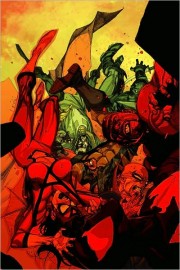 Michael J. Grabowski: Michael J. Grabowski:This is subjective, but I think it is "the way comics unfold now" that would make me say "whoa" before paying $10 for 3 comics. A friend of mine loaned me some New Avengers trades last month. I enjoyed the temporary time trip to my youth when I cared enough about these characters, and (not having read any Marvel Comics in at least 15 years) the whole rogue operations of SHIELD plot is 24-enough to make me almost interested in catching up, but I was kind of astonished at how short each individual chapter seemed, and how little the stories progressed from one chapter to the next. Were these really entire individual issues the first time around? I could read each chapter during the typical prime-time commercial break. The story page count per issue might be the same as it was in the 70's-80's, but the storytelling sure isn't the same. That's the sort of result that would have me reevaluating my purchases when it comes time to tighten my belt. (Even the trade editions read too quickly to seem like worthy purchases to me.)
It doesn't apply to all of them -- last spring I could spend $10 in one visit to buy Speak of the Devil, Berlin, and American Splendor (Vertigo) and know confidently that I would enjoy the reading experience that afternoon -- and the opportunity to re-read them later -- more than I would miss the money. That may say more about my reading taste now, but what I mean by it is that were I looking at books to cut from my monthly habit in order to save money, the amount of satisfying story, measured in part but not only by how long I could expect to take to read each book, would be a primary criterion. John Vest:With the price of a single comic book at $3 (or often more these days) it is hard to feel like you get the value for your money spent.
For starters, the shrinking number of outlets to obtain comics has made the journey to buy them more expensive along with the cover cost. I'm also beginning to wonder if there is a point in the existence of the 32 page comic book with the current content. The modern mainstream comic, with the five to six part story arcs and measured pacing, has been supplanted by the trade and hardcover editions. Contemporary mainstream serial comics don't read as functionally or feel satisfying.
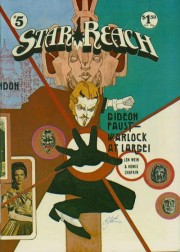 As screwy as mainstream comics had gotten by 1977, comic buying during that period was a spontaneous enjoyment. Even in the small southwestern Virginia town I grew up in (pop. 6000) comics were easily obtainable. They were available for purchase at the newsstand, convenience stores, the supermarket and drugstore, etc. Mail order helped pick up the slack for back issues or specialties like Star*Reach and UGs. As screwy as mainstream comics had gotten by 1977, comic buying during that period was a spontaneous enjoyment. Even in the small southwestern Virginia town I grew up in (pop. 6000) comics were easily obtainable. They were available for purchase at the newsstand, convenience stores, the supermarket and drugstore, etc. Mail order helped pick up the slack for back issues or specialties like Star*Reach and UGs.
For better and/or worse the comic book in the mid-'70's held casual and nonchalant pleasures for the inexpensive price. Covers were designed to grab the consumer, with a cheap hook or greatness. The George Baker illustrated Sad Sack covers made you laugh out loud and so did some of the absurdities on the Charlton horror covers. Jack Kirby's wonderful cover commentary ("Does Man Belong In A Zoo?" on the front of Kamandi #6) was timelessly weird and irresistible. Luis Dominguiz and Mike Kaluta jackets were amazing works of art to find in the context of a newsstand or convenience store spinner rack.
Around a month ago there was a discussion about the distinctive '70s kind of writing contained in Giant-Size Defenders #3. For better or worse again, the stories of that time had an immediately accessible nature. The best comics from writers like Roy Thomas and Steve Gerber also gained an intensity in the way Thomas' adaptations and Gerber's satire transcended the corporate comics trappings.
Going to a convention like Heroes also puts the current marketplace in perspective. It seems odd when you can pick up a decades old comic in decent shape with art by Jack Kirby or other greats for a lower price than a new comic.
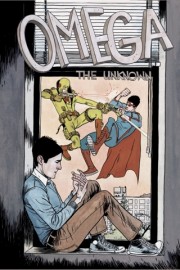 There are still comics out there that make you glad to have the single issues over a book. The look of Omega The Unknown makes going with the trade seem unimaginable. There's also the sense of lineage in buying the 32 page Army@Love by Rick Veitch with the scabrous social commentary he produced in comics years ago for Archie Goodwin. There are still comics out there that make you glad to have the single issues over a book. The look of Omega The Unknown makes going with the trade seem unimaginable. There's also the sense of lineage in buying the 32 page Army@Love by Rick Veitch with the scabrous social commentary he produced in comics years ago for Archie Goodwin.
The Bendis/Maleev run on Daredevil though really does seem much more suited to read in a book. The story which took five years to tell lives up to the "graphic novel" label. Maybe the grounded look of the art without the traditional comic book language (like Gene Colan's wonderful sweeping motion lines) makes the work seem less like a standard format comic.
Comics have changed significantly with the way they are crafted along with the price. Reading a comic was a casual pleasure in 1977. Today a comic book often seems like an expensive anomaly. Mike McGhee had a couple of interesting thoughts in a brief note I hope he won't mind my repeating here.
Mike McGhee:When considering the investment/return dynamic of modern comics, we absolutely have to consider the emotional return of the investment. For the price of three comics, with a deeply personalized emotional return that layers upon a five to forty-five year complexity, and a shared group of one to thirty or so, we get a movie with a social interaction potential that reaches across culture. As these fans get older, 'rusty brown' as they may be, that social component grows in power.
There is also, of course, the time factor. Even on initial usage, the time allotted for three issues is nearly half that of a movie. perhaps if you ran the inflation chart at a 'per/page' rate instead of 'per/comic?' That economic factor certainly seems to hold sway in Japan as well. I find the idea that a comic book isn't ever a single purchase but one of many in a wider investment that allows for more meaning and significance in the act of reading a single purchase to be quite the notion, one worth mulling over for sure.
Moving along, Steve Block had some ideas taking issue with a couple of things I wrote in an earlier essay.
Steve Block:Tom, I just want to pick you up on this:"I think there are differences between comics and music/video -- the immediacy of their secondary identity as collectibles, the significant differences in the aesthetic experience, their perceived lack of market saturation, the size and mainstream status of their ideal markets, the relative possibility for ad support, the more significant role of comics shops as venues of influence, the pliability of comics shops and resulting inability to dictate terms -- that suggest to me there are possibilities that the system best suited to deliver digital comics content could involve unique solutions." 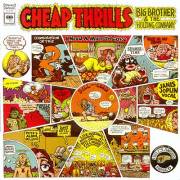 First up, I'm making an assumption here that may be wrong, but I'm thinking you have never been a vinyl junkie. Because, if you had, the first two of your points, the immediacy of their secondary identity as a collectible and the idea that their are differences in the aesthetic experience would not have been considered. I say this as a vinyl single or album has this inherent appeal to a collector's mentality too. The aesthetic qualities of an album include the size, the artwork, the sleeve notes and the tactile interaction. For more on vinyl as a collectible, see [this]. First up, I'm making an assumption here that may be wrong, but I'm thinking you have never been a vinyl junkie. Because, if you had, the first two of your points, the immediacy of their secondary identity as a collectible and the idea that their are differences in the aesthetic experience would not have been considered. I say this as a vinyl single or album has this inherent appeal to a collector's mentality too. The aesthetic qualities of an album include the size, the artwork, the sleeve notes and the tactile interaction. For more on vinyl as a collectible, see [this].
I think, to tackle your later points it's probably an area where we'd get into a debate about definitions. I don't perceive any lack of market saturation for any of the media at the minute, to be honest. It seems like the market is fairly healthy for all forms of entertainment at this exact point in time, allowing for the fact that we are at the very beginning of a likely unavoidable global recession. I think the size of an ideal market depends upon what you are comparing. Certainly the form of comics has reached as many people as all the other forms, so below that it gets hard to work out what to compare. Are American superhero comic books more comparable to alt rock, jazz fusion or drum and bass maybe? And at this comparison point, you can start to dismantle the latter of your points, because a specialist drum and bass store, for example, is just as influential and significant as a comic shop, and just as pliable.
Regarding ad support, I really don't see what point you are seeking to make here, sorry.
As to the idea that "the system best suited to deliver digital comics content could involve unique solutions", you are more likely to find legs for that argument if you start to look at how the printed media have embraced digital download. If we start to look at format, we can see that the shorter forms of comics share similarities with the shorter forms of prose, poetry and more significantly news, where editorial comics and strip cartoons have partial roots. News is simply published on the web, and paid for through ads or subscriptions. We already have that model for comic strips and cartoons, as you've noted with your piece on the United Media revamp. I think again there's a broader point you may be missing in your coverage of that; compare it to youtube. By giving away the ability to embed, you're advertising the site and building brand awareness. And the link between content and advertising has never been greater.
And to the last, the long form comics works, whatever we call them this week. There digital future is more closely entwined with the digital future of the novel. If I were in the business of publishing comics, I'd be talking to apple or friendly devs about how to get them on the i-phone/ipod through something like stanza. Now I admit to being behind the curve here and that it may already have been done. If it hasn't... because if the publishers don't work it out, you can be sure the market will, and if the market gets there first, well... creators want to reach an audience. A publisher is the middle man in the transaction.
Just some thoughts you inspired, at any rate. I think this deserves some explanation. First, I do recognize that books and music have a secondary status as collectibles. I just think that comics have a more significant identity as a collectible and as an object than those two things do, and I think that any move into comics on-line has to take that into account in more forthright fashion than has been done so far. Second, as far as ad support I think that the serial progression through space that comics provides allows for advertising in different ways than banner ads or border configurations. If nothing else, you can have ads appear in a reader the same way they do in comic books. I can't be the only person who thinks that Hulu.com's significant contribution to pay models for video is that unavoidable commercial break gimmick. Third, in general I want it to be known that I really do support the move of material on-line. I just don't think it's automatically an either/or situation, and I'm worried that these moves are going to be made with little to no consideration for the creators.
Finally, I had a couple more very good letters on the issue of cost. As you may recall, this chart by Rich Johnston said yes; this replay by Stuart Immonen says no. Dean Milburn weighed in on the two charts with some analysis of his own.
Dean Milburn:Stuart Immomen's analysis is incorrect, because his methodology assumes that the cumulative effect of prior year’s price increases is the same as the average GDP increase for the same period. For example -- the first increase in comics prices is from $.30 to $.35, a 16.7% increase, whereas the CPI implies an increase of less than half that (his correct number of 7.6%), to about $.32 cents. He’s mixing and matching the actual price increase (which may be higher or lower than the CPI) and than applies the CPI to it for a single year. All he’s really proven is that the expected price increase from 2007 to 2008 should have been from $2.99 to $3.15.
The errors compound. To go from $.30 cents to $3.15 over 31 years, implies an average annual inflation rate of 7.9%, while taking Rich Johnston’s numbers, from $.30 to $1.09 implies an average annual inflation rate of about 4.2%. The 4.2% number is the correct one.
Another way to look at it is from this table from The Economic Report of the President.
You'll see that $.606 cents in 1977 is equivalent to $2.073 in 2007. Which makes the math fairly easy -- $.30 in 1997 is worth about $1.03 in 2007.
I'd like to thank Professor Niggle for getting all that through to me about 20 years ago. Thanks, Dean. Here's Adam Stephanides working roughly the same area.
Adam Stephanides:I also found Stuart's chart opaque at first glance. After some thought, here's how I think it's supposed to be read; if I'm wrong, I apologize to Stuart in advance. To make it easier to follow, I'll take an arbitrary row, say 2001. Column 1 is the year, obviously. Column 2, taken from Rich Johnston, is the price of comics (which? Amazing Spider-Man? the "standard price point"? Rich doesn't say, and neither does Stuart) in 2001. Column 3, again taken from Rich, is what comics would have cost in 2001 if their price since 1977 had exactly kept pace with the general inflation rate. Putting it a bit more technically, it's what comics would have cost in 2001 in "nominal dollars" if their cost in 1977 dollars had remained constant. (If this doesn't mean anything to you, just ignore it.)
Column 4 shows the percentage change in the consumer price index (CPI) between 2000 and 2001: in other words, the yearly rate of inflation. Column 5, which I believe is intended to be the point of Stuart's table, shows what comics would have cost in 2001 if they had cost in 2000 what they actually did, but their price had risen between 2000 and 2001 at exactly the rate of inflation. Putting it in a formula, Col. 5 (2001) = Col. 2 (2000) X CPI(2001)/CPI(2000). In other words, it's the same thing as column 3, but using 2000 instead of 1977 as the "base year." And in general, each entry in column 5 uses the previous year as the base year.
Frankly, I don't see the relevance of column 5. All it shows is that in some years the price of comics doesn't change at all, and in some years it rises by more than the rate of inflation. It doesn't say anything about long-term trends. For that, column 3 is the relevant column. Nor do I understand why Stuart says "when one compares figures over a thirty year gap, the results are invariably skewed" (unless he's talking about possible cumulative bias in the CPI, which is a contentious subject among economists). Doing a bit of figuring, you can deduce from column 3 that even after adjusting for inflation, comics cost more in 1987 than they did in 1977, and more in 1997 than they did in 1987, and more in 2008 than they did in 1997. In all, after adjusting for inflation, comics cost approximately 2.74 times as much in 2008 as they did in 1977 (a figure obtained by dividing column 2 by column 3).
The most straightforward way to compare the rise in comic book prices with inflation would be to simply calculate inflation-adjusted comic book prices (i.e. comic book prices in 1977 dollars) for each year. Thanks, Adam. Now I feel bad because I know that Stuart sent that to me for use and not publication, but was nice enough not to yell at me when I assumed the latter. Me, at this point I've given up on numbers and gone back to using The Force to tell me when things are too expensive and when they're not. Luckily, Kenny Penman doesn't believe in outdated pop culture gags as a way to process real economic issues even in the general and suggests an explanation for why it may feel like comics cost more no matter if they are or not.
Kenny Penman:It's because most things have fallen in price in real terms and salaries don't accelerate for mostâ€."Like you buy a book or go to a movie and you may think about the price maybe 1 out of 20 times in crotchety old man fashion but you go to the comic shop and you buy three comic books for $10 and you're like 'whoa' every time. Maybe there's a threshold at which things seem more expensive? Maybe it's a hang-up about comics? Maybe it's differences in technology changing the landscape for comparisons? Maybe it's the way comics unfold now? I don't know. I'm with you on the feeling that comics have just got too expensive. I suspect some of it is to do with the way peoples earnings rise - they tend to peak out and go nowhere and the fact that a large number of things seem to have fallen in price in real terms. So if you have been in for the long term you will notice the difference.
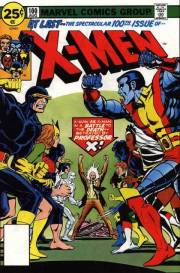 When I was first in a decent job around 25 years ago I was earning around 16K and comics cost from memory about 35p -- around the time of X-Men #100. A comic was a small part of my earnings -- I could buy 88,900 comics with my annual salary. Today 25 years later with an average comic at roughly 1.85 I can buy around 27,000 comics. When I was first in a decent job around 25 years ago I was earning around 16K and comics cost from memory about 35p -- around the time of X-Men #100. A comic was a small part of my earnings -- I could buy 88,900 comics with my annual salary. Today 25 years later with an average comic at roughly 1.85 I can buy around 27,000 comics.
Now some of that may be that I haven't become as wealthy as I should -- although I never felt remotely poor on my earlier salary or today's -- but that seems some concrete clear evidence that they simply have become in % terms a much, much more expensive commodity than they were.
Given that most peoples salaries probably don't increase six or seven times from where they first reach a level of "acceptable salary" clearly for most, comics buying has become a significantly more expensive hobby.
I know that ain't exactly maths or economics but it's a real world case for how expensive they've become.
In contrast back then a new record cost me 50p -- I could buy around 32,000 with my salary. Today I can still buy close to 10,000. Two-thirds less admittedly but not the monstrous 90%-ish less I can buy for comics. Unfortunately, Kenny sucks at math just like I do. His follow-up note: looking at a 25 cent book -- I was actually able to buy 88,900 -- now i can buy 27,000 -- OOPS missed a point out there. so it's about a 75% decline in spending power. Still outstripping records but not by so much. Maybe we are all just poorer. Thanks, everyone. Please participate in 5FF!
posted 7:15 am PST | Permalink
Daily Blog Archives
November 2019
October 2019
September 2019
August 2019
July 2019
Full Archives

|
|
 |
|
 |
 |
|
|

